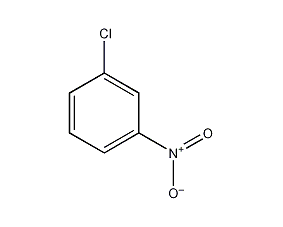
Structural formula
| Business number | 03E0 |
|---|---|
| Molecular formula | C6H4ClNO2 |
| Molecular weight | 157.56 |
| label |
1-Chloro-3-nitrobenzene, 3-chloronitrobenzene, m-nitrochlorobenzene, 3-Nitrochlorobenzene, m-chloronitrobenzene, m-nitrochlorobenzene, m-chloronitrobenzene, 1-Chloro-3-nitro-benzene, 1-Chloronitrobenzene, 1-Nitro-3-chlorobenzene, 3-Chloro-1-nitrobenzene, Chloro-m-nitrobenzene, Metachloronitrobenzene, m-nitrochlorobenzene(1-chloro-3-nitrobenzene), Multifunctional solvents, aromatic compounds |
Numbering system
CAS number:121-73-3
MDL number:MFCD00007202
EINECS number:204-496-1
RTECS number:CZ0940000
BRN number:1907947
PubChem number:24869572
Physical property data
1. Character: light yellow crystal[1]
2. Melting point (℃): 44~46[2]
3. Boiling point (℃): 235~236[3]
4. Relative density (water=1): 1.53[4]
5. Critical pressure (MPa): 3.98[5]
6. Octanol/water partition coefficient: 2.41~2.46 [6]
7. Flash point (℃): 127[7]
8. Solubility: insoluble in water, soluble in water Compatible with most organic solvents. [8]
Toxicological data
1. Acute toxicity[9] LD50: 420mg/kg (rat oral)
2. Irritation No data yet
3. Carcinogenicity [10] IARC Carcinogenicity Comment: G3, insufficient evidence of carcinogenicity to humans and animals.
Ecological data
1. Ecotoxicity[11] LC50: 1.2mg/L (96h) (fish)
2. Biodegradation Properties No data available
3. Non-biodegradability No data available
Molecular structure data
1. Molar refractive index: 37.69
2. Molar volume (cm3/mol): 113.2
3. Isotonic specific volume (90.2K ): 298.6
4. Surface tension (dyne/cm): 48.3
5. Polarizability (10-24cm3): 14.94
Compute chemical data
1. Reference value for hydrophobic parameter calculation (XlogP): None
2. Number of hydrogen bond donors: 0
3. Number of hydrogen bond acceptors: 2
4.Number of rotatable chemical bonds: 0
5. Number of tautomers: None
6. Topological molecule polar surface area 45.8
7. Number of heavy atoms :10
8. Surface charge: 0
9. Complexity: 134
10. Number of isotope atoms: 0
11 .Determine the number of atomic stereocenters: 0
12. Uncertain number of atomic stereocenters: 0
13. Determine the number of chemical bond stereocenters: 0
14. Number of uncertain chemical bond stereocenters: 0
15. Number of covalent bond units: 1
Properties and stability
1. Stability[12] Stable
2. Incompatible substances[13] Strong oxidizing agent, strong alkali, strong reducing agent
3. Conditions to avoid contact[14] Heating
4. Polymerization hazard[15] No polymerization
5. Decomposition products[16] Nitrogen oxides, hydrogen chloride
Storage method
Storage Precautions[17] Store in a cool, ventilated warehouse. Keep away from fire and heat sources. The packaging is sealed. They should be stored separately from oxidants, reducing agents, alkalis, and food chemicals, and avoid mixed storage. Equipped with the appropriate variety and quantity of fire equipment. Suitable materials should be available in the storage area to contain spills.
Synthesis method
1. Obtained from chlorination of nitrobenzene in the presence of iron filings. Add dry nitrobenzene and iron filings to the chlorination tower, vent chlorine gas, and control the reaction temperature at 40-45°C. When the relative density of the reaction material is 1.35 (25°C) and the freezing point is 23°C, it is the end point and the chlorine flow is stopped. Use compressed air to blow away chlorine and hydrogen chloride for 3 hours, wash the chlorinated materials with water until they are neutral, perform fractional distillation under reduced pressure, cut the fractions with a freezing point above 22°C and put them into the crystallizer, cool, lower the temperature to 13°C, keep it for 2 hours, and then raise the temperature. When the freezing point reaches 43°C, melt the materials in the crystallizer to obtain the product.
Purpose
1. Dye intermediates. Used in the preparation of m-chloroaniline (orange-based GC). It is also used in the auxiliary, pesticide, pharmaceutical and spice industries.
2. Used as an intermediate in organic synthesis. [18]

 微信扫一扫打赏
微信扫一扫打赏

